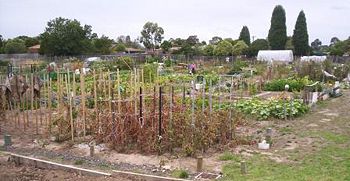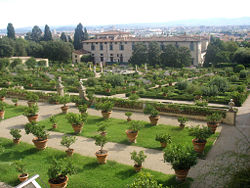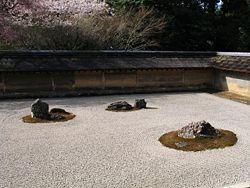Difference between revisions of "Gardening" - New World Encyclopedia
David Doose (talk | contribs) m |
David Doose (talk | contribs) m |
||
| Line 7: | Line 7: | ||
[[Image:gardening.jpg|thumb|right|200px|A gardener]] | [[Image:gardening.jpg|thumb|right|200px|A gardener]] | ||
| − | Gardening also takes place in non-residential green areas, such as [[park]]s, public or semi-public gardens ([[botanical garden]]s or [[zoological garden]]s), [[amusement park|amusement]] and [[theme park]]s, along transportation corridors, | + | Gardening also takes place in non-residential green areas, such as [[park]]s, public or semi-public gardens ([[botanical garden]]s or [[zoological garden]]s), [[amusement park|amusement]] and [[theme park]]s, along transportation corridors, around [[tourism|tourist attractions]] and [[garden hotels|hotels]]. In these situations, a staff of [[gardener]]s or [[groundskeeper]]s maintain the gardens. |
[[Image:Flowers_in_Park_Seed_Company_garden.jpg|thumb|left|200px|Flower gardens combine plants of different heights, colors, textures, and fragrances to create interest and to delight the senses. ''Photo by Ashley Sheets, provided courtesy of [[Park Seed Company]].'']] | [[Image:Flowers_in_Park_Seed_Company_garden.jpg|thumb|left|200px|Flower gardens combine plants of different heights, colors, textures, and fragrances to create interest and to delight the senses. ''Photo by Ashley Sheets, provided courtesy of [[Park Seed Company]].'']] | ||
| + | |||
| + | The types of gardens and the vast variety of purposes for which they are used is a testament to mankind's creative use of the materials that make up the natural world. | ||
== History == | == History == | ||
| − | Gardening for food extends far back into [[prehistory]]. A planned and maintained garden allowed for a consistant small food supply for a family or a small community. Historically, most fruit and vegetable gardening has leaned toward the practice of having a variety of types of | + | Gardening for food extends far back into [[prehistory]]. A planned and maintained garden allowed for a consistant small food supply for a [[family]] or a small [[community]]. Historically, most [[fruit]] and [[vegetable]] gardening has leaned toward the practice of having a variety of types of [[plant]]s on a small plot of land. |
| − | [[Ornamental Gardens|Ornamental gardens]] were known in ancient times, a famous example being the [[Hanging Gardens of Babylon]]. Ancient Roman ruins have revealed that wealthy Romans had gardens to beautify their homes and estates. | + | [[Ornamental Gardens|Ornamental gardens]] were known in ancient times, a famous example being the [[Hanging Gardens of Babylon]]. Ancient [[Rome|Roman]] ruins have revealed that wealthy Romans had gardens to beautify their homes and estates. |
| − | For millenia, gardens were not only created for | + | For millenia, gardens were not only created for aesthetic beauty, but were often created to attract special [[insect]]s such as [[Butterfly|butterflies]] or various types of [[bird]]s and [[animal]]s. Gardens have been grown for fragrance, medicinal purposes and to structurally enhance public and private properties. |
| − | In the days of the newly explored American frontiers, pioneers learned how to live off the land as they traveled ever further westward. As people settled, they planted gardens and | + | In the days of the newly explored American frontiers, [[American pioneer|pioneers]] learned how to live off the land as they traveled ever further westward. As people settled, they planted gardens and [[orchard]]s for immediate sustenance. [[Agriculture|Farming]] the land for cash crops took much more effort. The home gardens of the early pioneers were sown with precious [[seed]]s and plants brought on the trek westward. [[Herb]]s for health and healing, vegetables, fruits and flowers could all be found in the home garden. The early American pioneers had to be self-sufficient for the sake of their own survival. Many of the original varieties of plants that were grown by the early homesteaders can still be found today. These varieties are known as [[heirloom plants]] among contemporary gardeners. There are garden clubs and organizations known as "seed savers" that continue to keep these historical plants and seeds perpetually available for interested gardeners. |
==Gardening compared to farming== | ==Gardening compared to farming== | ||
Revision as of 04:59, 25 September 2007
A Garden is a planned space, usually outdoors, set aside for the display, cultivation, and enjoyment of plants and other forms of nature. The garden can incorporate both natural and man-made materials. Gardening is the activity of growing and maintaining the garden.
Gardening includes the growing of flowering plants, vegetables, and fruits. Although a garden typically is located on the land near a residence, it may also be located in a roof, in an atrium, on a balcony, in a windowbox, or on a patio or vivarium. Gardening can provide a satisfying emotional outlet for the individual who loves to be outdoors or a year-round pursuit for those fortunate enough to have a greenhouse. Gardening not only connects people to the natural world in a fun and purposeful way, but can be very educational and lead to a lifelong love of the plant world. People of all ages can enjoy the experience of gardening. Children, especially, can be introduced to the mysteries of life, growth and death through observations in a small garden of their own.
The reference to someone having a "green thumb" is accorded to those who are successful gardeners. In the United States, Canada, and Australia there are Master Gardener programs promoted by many university extension programs for the purpose of not only educating the individual but for spreading the knowledge of gardening practices to the public at large. Most Master Gardener programs require their graduates to volunteer a certain number of hours per year to share their gardening expertise with their communities.
Gardening also takes place in non-residential green areas, such as parks, public or semi-public gardens (botanical gardens or zoological gardens), amusement and theme parks, along transportation corridors, around tourist attractions and hotels. In these situations, a staff of gardeners or groundskeepers maintain the gardens.
The types of gardens and the vast variety of purposes for which they are used is a testament to mankind's creative use of the materials that make up the natural world.
History
Gardening for food extends far back into prehistory. A planned and maintained garden allowed for a consistant small food supply for a family or a small community. Historically, most fruit and vegetable gardening has leaned toward the practice of having a variety of types of plants on a small plot of land.
Ornamental gardens were known in ancient times, a famous example being the Hanging Gardens of Babylon. Ancient Roman ruins have revealed that wealthy Romans had gardens to beautify their homes and estates.
For millenia, gardens were not only created for aesthetic beauty, but were often created to attract special insects such as butterflies or various types of birds and animals. Gardens have been grown for fragrance, medicinal purposes and to structurally enhance public and private properties.
In the days of the newly explored American frontiers, pioneers learned how to live off the land as they traveled ever further westward. As people settled, they planted gardens and orchards for immediate sustenance. Farming the land for cash crops took much more effort. The home gardens of the early pioneers were sown with precious seeds and plants brought on the trek westward. Herbs for health and healing, vegetables, fruits and flowers could all be found in the home garden. The early American pioneers had to be self-sufficient for the sake of their own survival. Many of the original varieties of plants that were grown by the early homesteaders can still be found today. These varieties are known as heirloom plants among contemporary gardeners. There are garden clubs and organizations known as "seed savers" that continue to keep these historical plants and seeds perpetually available for interested gardeners.
Gardening compared to farming
In respect to its food producing purpose, gardening is distinguished from farming chiefly by scale and intent. Farming occurs on a larger scale, and with the production of saleable goods as a major motivation. Farming is generally a full-time commercial activity involving large land usage, irrigation systems, chemical fertilizers, and an investment in heavy equipment to prepare, plant and harvest crops. Gardening is done on a smaller scale, primarily for pleasure and to produce goods for the gardener's own family or community. Gardening is labor-intensive and employs very little infrastructural capital, typically no more than a few tools, e.g. a spade, hoe, basket and watering can.Sometimes there is an overlap between farming and gardening because some moderate-sized vegetable growing operations called market gardens are considered to be farming on a small scale. Hobby farming is another term used to describe gardening or raising livestock on the smallest of levels by one family as a very basic income supplement, usually on an acreage of 5 or less acres.

In part because of labor intensity and aesthetic motivations, gardening is very often much more productive per unit of land than farming. In the former Soviet Union, half the food supply came from small peasants' garden plots on the huge government-run collective farms, although they were tiny patches of land.
The term precision agriculture is sometimes used to describe gardening using intermediate technology (more than tools, less than harvesters). This form of gardening is found especially especially in small organic farming operations.
Community gardening is a growing movement across the USA and in some countries such as Great Britain and Australia. Small plots are made available to urban dwellers to plant for personal use. Many community gardens can be found on land that is vacant, and often in inner city areas. Community gardening brings people together, beautifies the neighborhood, and creates a sense of ongoing care for the local environment.
Gardens as art
Garden design is considered to be an art in most cultures, distinguished from gardening, which generally means garden maintenance. In Japan, for instance, Samurai and Zen monks were often required to build decorative gardens or practice related skills like flower arrangement known as ikebana. In 18th century Europe, country estates were refashioned by landscape gardeners into formal gardens or landscaped parklands, such as at Versailles, France or Stowe, England. Today, landscape architects and garden designers continue to produce artistically creative designs for private garden spaces.
Gardening in all its forms has become a major part of modern living for both rural and urban dwellers. Seasonal seeds and bedding plants can be found not only in the traditional plant nurseries, but also at grocery stores, drug stores, and many department stores. Many of today's one-stop department stores have gardening departments complete with furniture, art, statuary, pond supplies and all manner of gardening supplies to create a place in the outdoors that is inviting and enjoyable. There are no boundaries to the imagination once one gets started with creating a unique garden of personal taste and affordability.
Social aspect
In modern Europe and North America, people often express their political or social views in gardens, intentionally or not. The lawn vs. garden issue is played out in urban planning as the debate over the "land ethic" that is to determine urban land use and whether hyperhygienist bylaws (e.g. weed control) should apply, or whether land should generally be allowed to exist in its natural wild state. In a famous Canadian Charter of Rights case, "Sandra Bell vs. City of Toronto", 1997, the right to cultivate all native species, even most varieties deemed noxious or allergenic, was upheld as part of the right of free expression, at least in Canada.
In the British Isles people often surround their house and garden with a hedgerow. Common hedge plants are privet, hawthorn, beech, yew, leyland cypress, hemlock, arborvitae, barberry, box, holly, oleander and lavender. The idea of open gardens without hedges is distasteful to many, they like privacy. This has the advantage to the wildlife that there is a habitat for the birds and other wild plants.
Gardening is thus not only a food source and art, but also a right. The Slow Food movement has sought in some countries to add an edible schoolyard and garden classrooms to schools. Some elementary schools in the USA have gardening clubs for elementary school children as extracurricular programs to foster interest and knowledge of gardening as well as a love for the outdoor environment.
In US and British usage, the production of ornamental plantings around buildings is called landscaping, landscape maintenance or groundskeeping, while international usage uses the term gardening for these same activities.
Garden pests
A garden pest is commonly known as a "weed" or insect that is unwanted or harmful to the type of garden that is grown. A weed is an uninvited plant pest which robs a garden crop of space, moisture and nutrients. Insect pests damage garden crops by feeding on garden plants and reproducing there. There are many types of controls for garden pests. For weed control, there is hoeing, hand pulling, and cultivating between plants to remove weeds. Some gardeners like to cover the ground between plants with dried grass clippings or a natural or plastic mulch to preserve soil moisture and limit weed growth. Herbicides are chemicals used to control or eliminate the spread of weeds. The gardener who wants to keep to natural methods will not use herbicides. Insect pests can be controlled in natural ways also. Interplantings of certain kinds of plants and flowers in the garden can be a repellant to insects to find their favorite plants. Keeping the soil healthy with ammendments and proper care of garden plants will help to avert disease and weakness in garden plants. Garden pests are opportunists and sickly or weakend plants will be the first targets for insect pests. Insecticides are chemicals put on or near the plants to be protected from insect pests. There are many effective and safe ways to control garden pests. A little research will yield many choices to solve pest problems.
Restrictions
Governments of most countries restrict imports of plant material. Due to the threat of invasive species of plants or the diseases and pests that may accompany them, there is a strict watch and awareness of transporting plants and pests across international borders. In the USA, there are also restrictive measures within states to limit transportation of certain home grown produce to stop the spread of insect pests and diseases. The milfoil plant which grows in lakes, has become one of the most noxious of all invasive plants in the USA. It is often spread by plants that cling to recreational water vehicles and are transported from one body of water to another by boaters who do not check for the plants on their machinery or equipment.
Notes
ReferencesISBN links support NWE through referral fees
- Stefan Buczacki. 1999. "Beginners Guide to Gardening". London, England. Conran Octopus Publishing. ISBN 1840911530
- Christopher Brickell. "The American Horticultural Society Encyclopedia of Plants and Flowers". 2002. DK Publishing. ISBN 0789489937
- Gardening 101: Learn How to Plan, Plant, and Maintain a Garden. 2000. New York, NY: Clarkson Potter/Publishers. ISBN 0609805479
- Bush-Brown, Louise Carter, James Bush-Brown, and Howard S. Irwin. 1996. America's Garden Book. New York: Macmillan USA. ISBN 0028609956
- Groves, Marjorie P. 1979. Better Homes and Gardens Complete Guide to Gardening. Des Moines: Meredith Corp. ISBN 0696000415
- American Horticultural Society. 2000. The American Horticultural Society Gardening Manual. New York, N.Y.: Dorling Kindersley. ISBN 0789459523
- Bartholomew, Mel, and Mel Bartholomew. 2006. All New Square Foot Gardening: Grow More in Less Space! Nashville, Tenn: Cool Springs Press. ISBN 1591862027
- Weishan, Michael, and Laurie Donnelly. 2006. The Victory Garden Companion: America's most popular gardening series offers expert advice for creating a beautiful landscape for your home. New York: Collins. ISBN 0060599774
- Calkins, Carroll C. 1978. Reader's Digest Illustrated Guide to Gardening. Pleasantville, N.Y.: Reader's Digest Association. ISBN 0895770466
- The Encyclopedia of Organic Gardening. 1978. Emmaus, Pa: Rodale Press. ISBN 0878572252
External links
- Museum of Garden History Cix.co.uk. Retrieved September 17, 2007.
- Expert Gardening Information Espertonthat.com. Retrieved September 16, 2007.
- Garden and Designed Landscape Types Gardenvisit.com. Retrieved September 16, 2007.
- Your Guide to Everything Gardening Gardenguides.com. Retrieved August 23, 2007.
- National gardening Association Garden.org. Retrieved August 23, 2007.
- Gardening Links Gardenweb.com. Retrieved August 23, 2007.
- Seven Arrows Sevenarrowsfarm.com. Retrieved September 16, 2007.
- Arizona Master Garden Manual Ag.arizona.edu. Retrieved August 23, 2007.
- Gardening at Dave's Garden Davesgarden.com. Retrieved August 23, 2007.
- Seed Savers Exchange. Seedsavers.org. Retrieved September 15, 2007.
Credits
New World Encyclopedia writers and editors rewrote and completed the Wikipedia article in accordance with New World Encyclopedia standards. This article abides by terms of the Creative Commons CC-by-sa 3.0 License (CC-by-sa), which may be used and disseminated with proper attribution. Credit is due under the terms of this license that can reference both the New World Encyclopedia contributors and the selfless volunteer contributors of the Wikimedia Foundation. To cite this article click here for a list of acceptable citing formats.The history of earlier contributions by wikipedians is accessible to researchers here:
The history of this article since it was imported to New World Encyclopedia:
Note: Some restrictions may apply to use of individual images which are separately licensed.


